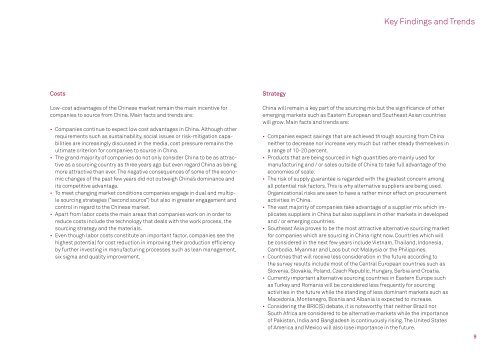01 | 2015 msg systems study
Sourcing in China
Sourcing in China
Create successful ePaper yourself
Turn your PDF publications into a flip-book with our unique Google optimized e-Paper software.
Key Findings and Trends<br />
Costs<br />
Low-cost advantages of the Chinese market remain the main incentive for<br />
companies to source from China. Main facts and trends are:<br />
••<br />
Companies continue to expect low cost advantages in China. Although other<br />
requirements such as sustainability, social issues or risk-mitigation capabilities<br />
are increasingly discussed in the media, cost pressure remains the<br />
ultimate criterion for companies to source in China.<br />
••<br />
The grand majority of companies do not only consider China to be as attractive<br />
as a sourcing country as three years ago but even regard China as being<br />
more attractive than ever. The negative consequences of some of the economic<br />
changes of the past few years did not outweigh China’s dominance and<br />
its competitive advantage.<br />
••<br />
To meet changing market conditions companies engage in dual and multiple<br />
sourcing strategies (“second source”) but also in greater engagement and<br />
control in regard to the Chinese market.<br />
••<br />
Apart from labor costs the main areas that companies work on in order to<br />
reduce costs include the technology that deals with the work process, the<br />
sourcing strategy and the materials.<br />
••<br />
Even though labor costs constitute an important factor, companies see the<br />
highest potential for cost reduction in improving their production efficiency<br />
by further investing in manufacturing processes such as lean management,<br />
six sigma and quality improvement.<br />
Strategy<br />
China will remain a key part of the sourcing mix but the significance of other<br />
emerging markets such as Eastern European and Southeast Asian countries<br />
will grow. Main facts and trends are:<br />
••<br />
Companies expect savings that are achieved through sourcing from China<br />
neither to decrease nor increase very much but rather steady themselves in<br />
a range of 10-20 percent.<br />
••<br />
Products that are being sourced in high quantities are mainly used for<br />
manufacturing and / or sales outside of China to take full advantage of the<br />
economies of scale.<br />
••<br />
The risk of supply guarantee is regarded with the greatest concern among<br />
all potential risk factors. This is why alternative suppliers are being used.<br />
Organizational risks are seen to have a rather minor effect on procurement<br />
activities in China.<br />
••<br />
The vast majority of companies take advantage of a supplier mix which implicates<br />
suppliers in China but also suppliers in other markets in developed<br />
and / or emerging countries.<br />
••<br />
Southeast Asia proves to be the most attractive alternative sourcing market<br />
for companies which are sourcing in China right now. Countries which will<br />
be considered in the next few years include Vietnam, Thailand, Indonesia,<br />
Cambodia, Myanmar and Laos but not Malaysia or the Philippines.<br />
••<br />
Countries that will receive less consideration in the future according to<br />
the survey results include most of the Central European countries such as<br />
Slovenia, Slovakia, Poland, Czech Republic, Hungary, Serbia and Croatia.<br />
••<br />
Currently important alternative sourcing countries in Eastern Europe such<br />
as Turkey and Romania will be considered less frequently for sourcing<br />
activities in the future while the standing of less dominant markets such as<br />
Macedonia, Montenegro, Bosnia and Albania is expected to increase.<br />
••<br />
Considering the BRIC(S) debate, it is noteworthy that neither Brazil nor<br />
South Africa are considered to be alternative markets while the importance<br />
of Pakistan, India and Bangladesh is continuously rising. The United States<br />
of America and Mexico will also lose importance in the future.<br />
9


















